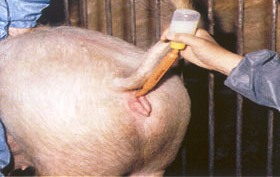
|
|
Live Stock :: Pig :: Artificial Insemination in Pigs |
|
ARTIFICIAL INSEMINATION IN PIGS AI in pigs poses special problems chiefly due to the anatomy of the reproductive tract and the polycotous nature of litter bearing. The glans penis of the boar enters the cervix during mating. A pressure is applied on the glans as it enters the cervical canal to facilitate ejaculation. Piggery development in our country is in isolated pockets. Though a good amount of information is available on pure and crossing of swines, looking to the vast multitude of our nation the progress is very slow. The boar matures between 6 and 8 months, and donates semen. The volume is quite large, about 200 to 500 ml. The ejaculations are in 3 sets. The first and third do not contain spermatozoa but the second is rich in sperms. Spermatozoa concentration per milliliter is low but the total count per ejaculate is as good as in bull. The semen from one ejaculate can be used in 15 to 25 females only as against about 400 cows from a bull's ejaculate. However, the total number of offspring’s reared may become the same looking into milliliter bearing nature and gestation length of the swine.
Insemination Boars are trained to mount live or dummy females (stuffed skins) and ejaculate. Smearing the dummy with the urine of female in oestrus enhances the libido and results in quicker ejaculations. As reported by McDonald (1969) "The boar's ejaculate is delivered in three portions. The pre-sperm portion is a sticky, strongly coherent, mucus substance, the second fraction contains the spermatozoa and the post-sperm fraction is a viscous, gel-containing portion. The gel constitutes 20 to 25 per cent of the total volume of the ejaculate. The average duration of ejaculation is about 10 minutes but varies considerably between boars". The oestrus in sows is of special significance. According to the Japanese workers about 76 kg body weight and 256 days of age is the puberty stage. Swelling and reddening of the vulva is a typical symptom that persists during oestrus, which spreads for 6-9 days. The oestrus seems to be of 2 to 3 days duration leaving the rest for pro- and met-oestrus. The anatomy of the female tract needs a different approach to AI. Three different types of catheters are used. Those interested are referred to a standard book on AI for details. These equipments differ in depositing the semen in different locations either in the cervix or in the uterine horn. Yolk-based diluents are used for boar's semen also. Quite a few workers have used milk-based diluents with success. Normally 5xl09 spermatozoa in about 50 ml volume are the recommended dose. Sows are preferably inseminated around 24 hour of standing heat. The post-partum heat in the sow is not ovulatory which is shown in a few days after farrowing. Sows are not bred at this stage. As per present day practice and fertility regulation pigs are weaned from suckling 6 to 8 weeks of age. This triggers a sudden spurt of follicular growth and the sow comes into heat around 5 days post-weaning and ovulates. This heat is used to breed the sow. such practice will help to harvest 2 crops per sow in a year. (Source: Dr.Acharya, Handbook of Animal Husbandry) |
|
| © 2009-15 TNAU. All Rights Reserved. |
|
